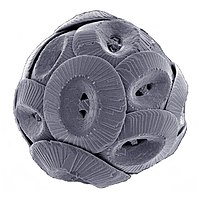
Photo from wikipedia
Abstract Microbially induced calcite precipitation (MICP) has applications in self-healing concrete, soil consolidation and bio-grouting. Development of models of processes involved in MICP is a step towards gaining mechanistic insights… Click to show full abstract
Abstract Microbially induced calcite precipitation (MICP) has applications in self-healing concrete, soil consolidation and bio-grouting. Development of models of processes involved in MICP is a step towards gaining mechanistic insights and building reliable predictive models of MICP. This work deals with understanding the reaction and transport processes involved in ureolysis mediated calcite precipitation in Sporosarcina pasteurii(S. pasteurii). Particularly, a simple structured model that describes urea uptake, ureolysis, ammonium assimilation and ammonium excretion processes is developed. The structured model describes extra-cellular processes like transport processes and important intra-cellular reactions involved in ureolysis. The model parameters are estimated using measured concentrations of extracellular and intracellular metabolites during experiments. In this work, The maximum specific growth rate and yield coefficient of S. pasteurii are found to be 0.78 d−1 and 4.93 gDW/g, respectively. The maximum urease activity of 1.79 μmoles/min/gDW biomass was observed during the fourth day of growth when grown in minimal media. It is shown that the urea uptake can be described by a first-order kinetics suggesting active transport. The estimated parameter of rate constant of first-order kinetics is 9.8 × 10−2d−1. On the other hand, the ammonium ion excretion takes place through free diffusion. The estimated parameter of permeability coefficient for ammonium ion diffusion is 9.2 × 10−3 m d−1.
Journal Title: Biochemical Engineering Journal
Year Published: 2021
Link to full text (if available)
Share on Social Media: Sign Up to like & get
recommendations!